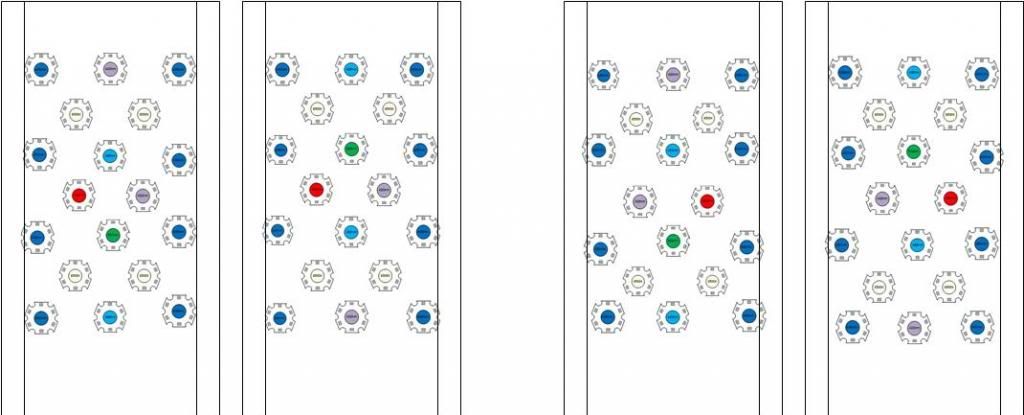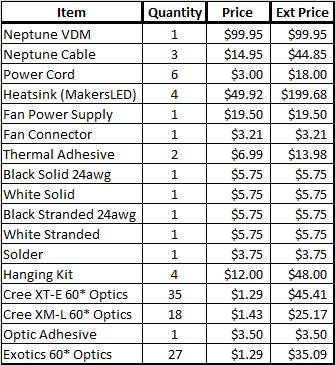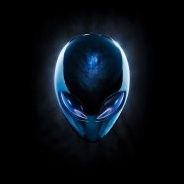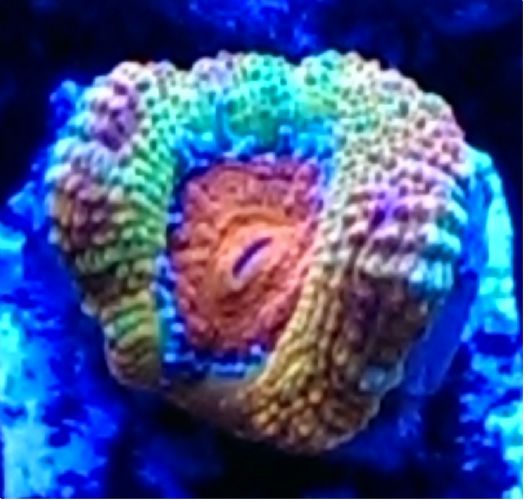| Author |
 Topic Search Topic Search  Topic Options Topic Options
|
ReefdUp 
Guest


Joined: March 20 2011
Location: South Weber
Status: Offline
Points: 4166
|
 Post Options Post Options
 Thanks(0) Thanks(0)
 Quote Quote  Reply Reply
 Topic: Review my LED Build? Please? Topic: Review my LED Build? Please?
Posted: September 20 2013 at 3:10pm |
Hi all, First up is the obligatory disclaimer that I have cross-posted this to make sure I'm not missing anything. I'd really appreciate any thoughts/concerns you have. It's my first build, so I want to make sure it's done right. Thanks in advance!! Tank: 150g tall (48" long by 24" wide by 31" tall) Inhabitants: Mostly SPS, some LPS Previous lighting: 2x400W MH + 2x54W T-5 Controller: Neptune Apex LEDs: Total LED Max Wattage: 312W, dimmable Cree XM-L2 Neutral White (5000K) Cree XT-E Royal Blue (455nm) Exotic Deep Red (660nm) Exotic Turquoise (495nm) Exotic Cool Blue (475nm) Exotic Hyper Violet (430nm) Layout:  LEDs & Forward Voltages:  Drivers:  Misc. Supplies:  I guess my last two big remaining questions are regarding driver/light combos. The Cree XM-L2 operates at 3000mA, so the forward voltage is 3.3V. I assume I can run the XM-L2's on the Mean Well ELN-60-48 at 1300mA, with no problems, right? Any recommendations on the Cree XT-E scenario above? The max voltage I'd have is 108.8V, but two Mean Well ELN-60-48 will only run 105.6V. I'd hate to run a third driver for that small of a difference. Parts are coming from www.LEDgroupbuy.com and www.rapidled.com. Thanks in advance!
Edited by ReefdUp - April 19 2014 at 4:14pm
|
|
www.reefdup.com
Diving since 2009, reefkeeping since 2007, & fishkeeping since 1987
200g, 75g, & 15g Systems
PADI Advanced Open Water
|
 |
lskurys 
Guest


Joined: September 01 2011
Location: Roy Utah
Status: Offline
Points: 1129
|
 Post Options Post Options
 Thanks(0) Thanks(0)
 Quote Quote  Reply Reply
 Posted: September 20 2013 at 3:54pm Posted: September 20 2013 at 3:54pm |
|
Looks pretty close to what I have set up right now.
|
|
220g , large elite aquatics sump. 3 Radion Pro Gen 3 lights 3 Mp 40's
|
 |
ReefdUp 
Guest


Joined: March 20 2011
Location: South Weber
Status: Offline
Points: 4166
|
 Post Options Post Options
 Thanks(0) Thanks(0)
 Quote Quote  Reply Reply
 Posted: September 20 2013 at 4:00pm Posted: September 20 2013 at 4:00pm |
|
Sweet.
I think I'm going to switch out the XM-L2 for an XT-E. It's cheaper, and it'll make the build easier.
|
|
www.reefdup.com
Diving since 2009, reefkeeping since 2007, & fishkeeping since 1987
200g, 75g, & 15g Systems
PADI Advanced Open Water
|
 |
phys 
Guest


Joined: March 04 2011
Location: Capitol Hill
Status: Offline
Points: 1982
|
 Post Options Post Options
 Thanks(0) Thanks(0)
 Quote Quote  Reply Reply
 Posted: September 20 2013 at 9:48pm Posted: September 20 2013 at 9:48pm |
|
I would either go with less neutral whites and get some cool whites, or just less neutral whites.. they really do cast A LOT of yellow on the tank. I have only 8 on my 150 and they totally change the look and they're running at the lowest acceptable power for the meanwell driver. Since the ones you chose put out more than the ones I have, they would cause even more yellow than you'd probably want.
I would also suggest some shorter wavelength violets that are around 400-430 with about a 415nm peak. They really do add a bit of flavor to the fluorescence of the corals and make some of the deep blue colors show up.
I also think that the turquoise would be a waste of money... if you went with less neutral whites and add some cool whites, that color range would be filled in better.
For the Deep red, you should look at the spectral output and make sure they supply the necessary (albeit not very much) wavelengths for chlorophyll A at the 690nm peak wavelengths. If you're going to do red, I think it would be best to do it at a wavelength used by your corals.
For the XT-E's, just get a higher amperage driver and split the current between two strands.. be sure to add some fuses... some people may disagree and say they wont help, but through LOTS of experience... they do.
|
 |
phys 
Guest


Joined: March 04 2011
Location: Capitol Hill
Status: Offline
Points: 1982
|
 Post Options Post Options
 Thanks(0) Thanks(0)
 Quote Quote  Reply Reply
 Posted: September 20 2013 at 9:55pm Posted: September 20 2013 at 9:55pm |
|
FYI, if any of your meanwell drivers blink the LEDs, it either means you need to increase your output or add more LEDs to the string.
|
 |
ReefdUp 
Guest


Joined: March 20 2011
Location: South Weber
Status: Offline
Points: 4166
|
 Post Options Post Options
 Thanks(0) Thanks(0)
 Quote Quote  Reply Reply
 Posted: September 21 2013 at 6:45am Posted: September 21 2013 at 6:45am |
|
Everywhere I've read recommended that number of neutral whites in a 2:1 ratio with the royal blues. If I went to a cool white, I'd have to drop the RB's to a 1:1 ratio. What ratio are yours?
I'm still considering some violets around 405nm, but from everything I've read, very few pigments have absorption peaks in that range (a tiny peak in Chl a...and dinoxanthin. BFP absorbs around 380nm, but I'm not sure I want to dip down into the actual UV range.) The major peaks will be covered by the hyperviolet at 430nm (Chl a peaks at 430nm, diadinoxanthin peaks at 425nm, Neo-dinoxanthin peaks at 425nm, and B-carotene peaks at 430nm. Cyan fluorescence absorbs around 400-450nm, so the 430nm should address this.)
The turquoise is to balance out the red and cool blue. Together the light appears white, but they individually help some fluorescence. More importantly, the turquoise is at 495nm. Green fluorescent proteins (GFP) are the most numerous proteins, and they have a peak absorption at 500nm. I wanted to make sure to excite the GFP's well enough.
As far as I'm aware, Chl a has a peak around 660nm (which is where the red covers). I've seen some aquarium-specific references to a 685nm peak, but it is much smaller than the 660nm and 430nm peaks. The 430nm peak is the largest absorption peak, which I covered with the hyperviolets. I'm purposefully avoiding the far-red as it nears IR. Coral xanthophylls convert blue-spectrum light into heat, but they do not have any protective measure for red-spectrum light...which causes the typical bleaching from red-overexposure. Lastly, I'm using the 660nm reds to balance out the turquoise & cool blue for the white effect.
|
|
www.reefdup.com
Diving since 2009, reefkeeping since 2007, & fishkeeping since 1987
200g, 75g, & 15g Systems
PADI Advanced Open Water
|
 |
Fatman 
Guest


Joined: December 23 2011
Location: South Weber, UT
Status: Offline
Points: 1694
|
 Post Options Post Options
 Thanks(0) Thanks(0)
 Quote Quote  Reply Reply
 Posted: September 21 2013 at 8:01am Posted: September 21 2013 at 8:01am |
|
..
Edited by Fatman - November 11 2013 at 7:12am
|
 |
Krazie4Acans 
Admin Group


Joined: December 17 2012
Location: Syracuse
Status: Offline
Points: 24177
|
 Post Options Post Options
 Thanks(0) Thanks(0)
 Quote Quote  Reply Reply
 Posted: September 21 2013 at 9:44am Posted: September 21 2013 at 9:44am |
Nikki I think you are going to find just as many opinions on this subject as anything else in this hobby. I like much of what Phys said. Here is what I recommend from building my own fixtures and modifying countless others:
Ratio of blues to whites. 2:1 Ratio of blues to other blues. RB 4: Blue 2: actinic (420nm) 1 Ratio of whites to other whites. NW 4: CW 2: WW 1 Other colors to supplement what you want in the tank. I've used reds, deep reds, pinks, greens, UV etc...
I think one of the most important lessons I have learned is the using analog dimmable drivers has the effect of changing the color spectrum produced by the LED. This doesn't seam like much but it does matter. With PWM drivers the LED is driven at it's optimum color and efficiency but turned on and off many times per second to reduce the output. In a tank that is SPS dominant this kind of detail can matter and should be considered.
Supplemental colors should be on separate drivers from the blues and whites. I no longer use UV LEDs as I have had bleaching issues on several tanks due to them. In your deeper tank it may not be an issue.
Meanwells also blink if you have too many LEDs on the string as well as the voltage being too low or not enough LEDs.
Hope some of that helps.
|
My ocean. 90g (yup, won it!), 40g, 28g, & 10g Systems PADI Advanced Open Water Tank Thread:
|
 |
phys 
Guest


Joined: March 04 2011
Location: Capitol Hill
Status: Offline
Points: 1982
|
 Post Options Post Options
 Thanks(0) Thanks(0)
 Quote Quote  Reply Reply
 Posted: September 21 2013 at 8:28pm Posted: September 21 2013 at 8:28pm |
|
Hi, just so i'm on the same page as you, could you provide some references to the suggestions for neutral white ratios? Personally, I have never read about what you've stated.
Here's my reasoning: If you look at the spectral output of the neutral white LEDs, it has a peak output close to 600 nm. This is a spectral area of the coral's absorption where it is minimal. My thoughts on this was since there is not very much absorption, I would use a cool white LED which has more power radiating toward the blue spectrum that is more utilized by the corals, which in turn gives you better efficiency for the purpose. To me, it seems a waste to have more radiative energy at a wavelength that is less utilized.
The reason I still use extreme violet (but not UV) LEDs is that the falloff of most of the royal blues is before the end absorption spectrum of the corals. I figure by adding a few (only 4) LEDs at the end of the blue spectrum would help increase the utilization of the light by the corals. I also figured that since the absorption was a fair amount less at the wavelength, I would use less light.
You state something about the GFP, but as I know it, the excitation wavelengths are 395 and 470nm with the 470nm spectrum being significantly lower (only 40%) than that of the previous. So you should only need about 40% of the light output at the wavelength to have a decent effect. Also, that would mean you would have to use some near UV lighting to get more of an effect for the GFP.
You're correct that Chl-A has the peak at 660 but the utilization of the wavelengths in the red by corals is minimal compared to the blue end of the spectrum. When I was referring to the 695nm peak, I was referring to Chl-B.
It is my understanding that corals use more carotenoids in their energy production than they do chlorophyll and since there are more peak absorptions by all three energy producing pigments, it would lead me to think that having more blue light in the aquarium with very minimal red supplementation (utilized by using a few neutral white LEDs instead of any red at all) would be a more wise choice.
If you want to see my build, just look for it in the forum. It'll tell you all the specifics of my reasoning and links to references.
Also, for those who want to read some of their own about this stuff.... http://phototroph.blogspot.com/2006/11/pigments-and-absorption-spectra.html ... basic once over for this.
Edited by phys - September 21 2013 at 8:30pm
|
 |
Krazie4Acans 
Admin Group


Joined: December 17 2012
Location: Syracuse
Status: Offline
Points: 24177
|
 Post Options Post Options
 Thanks(0) Thanks(0)
 Quote Quote  Reply Reply
 Posted: September 21 2013 at 9:42pm Posted: September 21 2013 at 9:42pm |
|
Hey Phys. As far as studies and literature I would have to see if I can dig any up. I haven't looked at much of the recent postings as I found most of it just restating things that I have already known or just doesn't match what I have seen in building and using LED fixtures for the last 3 years.
I Have had systems that were fully CW and a few blues, I have had others that were 50/50, I have had them with 66/33 Blues to white. I've had systems in the latter two configurations with only Neutral Whites. My current setup has the above mentioned mix of blues and whites along with a pink, green and red with the best coloration and growth response on any of the configurations I have seen or used. I also looked into the AI's and Radions and all of there new systems are using more Neutral White to Cool White and more blue than white. They are also using a mix of RB, B, and 420nm actinic. Some have red and green and others don't.
I'm not sure about your reading but mine always led me to believe that there is still not a ton of solid information about what spectrum corals actually use. They have figured out which ones excite the coral tissues but in my readings they still have not been able to equate what levels of excitement produce growth compared to color. Like I said before It's been a few months since I checked for the current info.
I have always been one to research the technology to understand how it works and what it's believed benefits are but then I let my corals and tank tell me the rest of the story. Being a tinkerer I'm sure I'm not done making changes and trying new configurations. However, this configuration has worked the best so far out of all of the ones mentioned above.
I wasn't trying to throw out information to try and change Nikki's mind as I am sure she has ready everything ever published on this stuff before she posted anything on here at all. I just wanted to add my bits of experience to the mix to give her some real examples instead of just theory and opinion. If she chooses to look into any of if then great, if she doesn't then that's great too. Either way I believe that the the available LED technology out there she will come up with something great that works for her deep tank.
I still think she should look into the spectral change due to current only dimming as I believe she will find that an interesting read if nothing else. She is always very cognoscente of the very fine details and I believe that this is an area overlooked by most.
|
My ocean. 90g (yup, won it!), 40g, 28g, & 10g Systems PADI Advanced Open Water Tank Thread:
|
 |
Krazie4Acans 
Admin Group


Joined: December 17 2012
Location: Syracuse
Status: Offline
Points: 24177
|
 Post Options Post Options
 Thanks(0) Thanks(0)
 Quote Quote  Reply Reply
 Posted: November 12 2013 at 8:58pm Posted: November 12 2013 at 8:58pm |
Reefdup I know you made some changes to your layout from the original post and what you currently have built. Can you post an update her with the new layout and maybe some reasoning behind the changes? That would be awesome! 
|
My ocean. 90g (yup, won it!), 40g, 28g, & 10g Systems PADI Advanced Open Water Tank Thread:
|
 |
ReefdUp 
Guest


Joined: March 20 2011
Location: South Weber
Status: Offline
Points: 4166
|
 Post Options Post Options
 Thanks(0) Thanks(0)
 Quote Quote  Reply Reply
 Posted: November 12 2013 at 9:00pm Posted: November 12 2013 at 9:00pm |
I will, but right now I'm up to my neck finishing my paper & build...it's due in a few days (at least the rough draft.) It'll need to wait until after I'm done. Sorry. Keep in mind, that what I was required to do for a thesis may not make 100% sense in the reefkeeping community. 
|
|
www.reefdup.com
Diving since 2009, reefkeeping since 2007, & fishkeeping since 1987
200g, 75g, & 15g Systems
PADI Advanced Open Water
|
 |
Krazie4Acans 
Admin Group


Joined: December 17 2012
Location: Syracuse
Status: Offline
Points: 24177
|
 Post Options Post Options
 Thanks(0) Thanks(0)
 Quote Quote  Reply Reply
 Posted: November 12 2013 at 9:14pm Posted: November 12 2013 at 9:14pm |
Based on the pictures in your other thread I think I have it figured out except for the three LEDs in the center row on the white wire on the top, bottom and middle of that center row. Wanna throw me a bone? 
|
My ocean. 90g (yup, won it!), 40g, 28g, & 10g Systems PADI Advanced Open Water Tank Thread:
|
 |
Fatman 
Guest


Joined: December 23 2011
Location: South Weber, UT
Status: Offline
Points: 1694
|
 Post Options Post Options
 Thanks(0) Thanks(0)
 Quote Quote  Reply Reply
 Posted: November 24 2013 at 11:02pm Posted: November 24 2013 at 11:02pm |
|
This thing is up on the 150. It's a 4 foot tanks so it's deep. These lights are outstanding. Looks like daylight when the whites are on at 15%. The color control (6 channels) is something to see. Nikki turned everything off and set the violets at 15% and the color was amazing.
Nice build. I had fun helping on this one. The colors in the tank are really coming along and the funny stick coral are spreading like crazy. This is a reef tour must see next year.
|
 |
ReefdUp 
Guest


Joined: March 20 2011
Location: South Weber
Status: Offline
Points: 4166
|
 Post Options Post Options
 Thanks(0) Thanks(0)
 Quote Quote  Reply Reply
 Posted: November 25 2013 at 5:41am Posted: November 25 2013 at 5:41am |
|
So, I just checked the program... The whites were only at 10%, and all others were at 15%. I'll run them there for 2 weeks before I bump them up. Kevin, I can't thank you enough.
More to come this weekend....need to finish my paper.
|
|
www.reefdup.com
Diving since 2009, reefkeeping since 2007, & fishkeeping since 1987
200g, 75g, & 15g Systems
PADI Advanced Open Water
|
 |
Krazie4Acans 
Admin Group


Joined: December 17 2012
Location: Syracuse
Status: Offline
Points: 24177
|
 Post Options Post Options
 Thanks(0) Thanks(0)
 Quote Quote  Reply Reply
 Posted: December 03 2013 at 11:01am Posted: December 03 2013 at 11:01am |
It's passed the weekend.............   lol
|
My ocean. 90g (yup, won it!), 40g, 28g, & 10g Systems PADI Advanced Open Water Tank Thread:
|
 |
ReefdUp 
Guest


Joined: March 20 2011
Location: South Weber
Status: Offline
Points: 4166
|
 Post Options Post Options
 Thanks(0) Thanks(0)
 Quote Quote  Reply Reply
 Posted: December 03 2013 at 11:31am Posted: December 03 2013 at 11:31am |
|
Yup...and now the final is due next week. I posted some to keep you guys appeased in my tank build thread. :-)
|
|
www.reefdup.com
Diving since 2009, reefkeeping since 2007, & fishkeeping since 1987
200g, 75g, & 15g Systems
PADI Advanced Open Water
|
 |
Krazie4Acans 
Admin Group


Joined: December 17 2012
Location: Syracuse
Status: Offline
Points: 24177
|
 Post Options Post Options
 Thanks(0) Thanks(0)
 Quote Quote  Reply Reply
 Posted: December 03 2013 at 11:55am Posted: December 03 2013 at 11:55am |
It didn't work. 
|
My ocean. 90g (yup, won it!), 40g, 28g, & 10g Systems PADI Advanced Open Water Tank Thread:
|
 |
ReefdUp 
Guest


Joined: March 20 2011
Location: South Weber
Status: Offline
Points: 4166
|
 Post Options Post Options
 Thanks(0) Thanks(0)
 Quote Quote  Reply Reply
 Posted: December 03 2013 at 12:13pm Posted: December 03 2013 at 12:13pm |
|
Yeah, yeah, yeah.
|
|
www.reefdup.com
Diving since 2009, reefkeeping since 2007, & fishkeeping since 1987
200g, 75g, & 15g Systems
PADI Advanced Open Water
|
 |
ReefdUp 
Guest


Joined: March 20 2011
Location: South Weber
Status: Offline
Points: 4166
|
 Post Options Post Options
 Thanks(0) Thanks(0)
 Quote Quote  Reply Reply
 Posted: December 08 2013 at 10:53pm Posted: December 08 2013 at 10:53pm |
So, here's the rough draft of my thesis. I know there are a few things I need to fix, but you're welcome to review it as well (haha...it's like 125 pages and almost 18,000 words.) Reef_Club_LED_Version.pdf
|
|
www.reefdup.com
Diving since 2009, reefkeeping since 2007, & fishkeeping since 1987
200g, 75g, & 15g Systems
PADI Advanced Open Water
|
 |